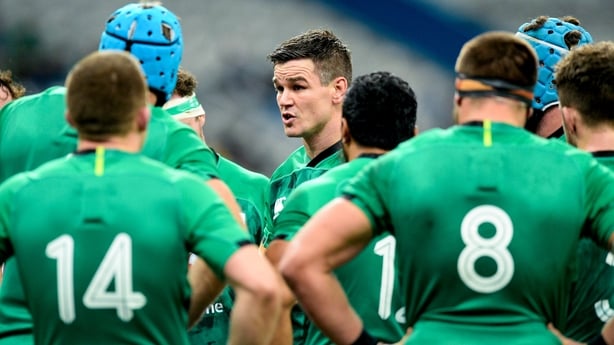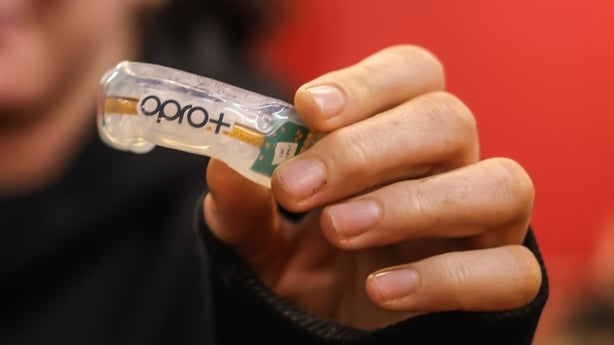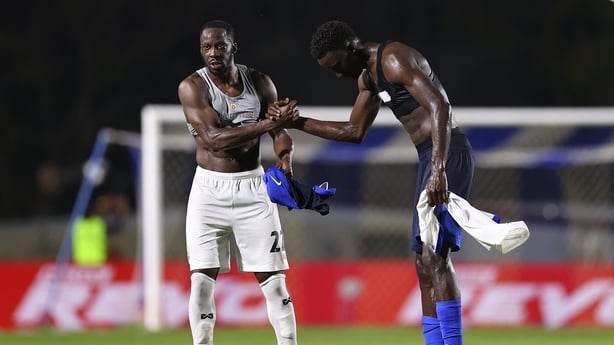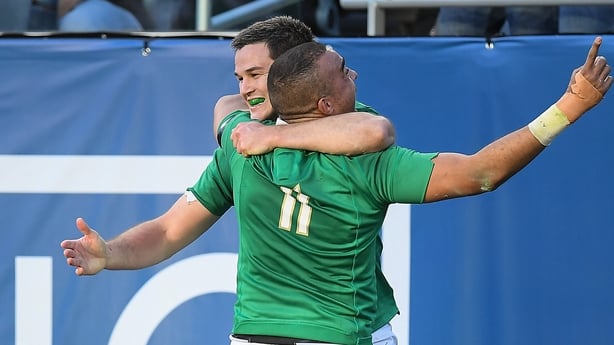If you've watched a rugby match recently, you may have noticed a small lump on the players’ backs.
That’s because their jerseys are specially designed to carry a performance tracker – kind of like a smartwatch, turned up to 11.
At the heart of the device is a GPS tracker – which can give a pretty precise reading on where the player is at any given time.
But, with that constant feed of that information, you can also see exactly where they’ve been moving on the pitch. And, from that, you can also see how much ground they’ve covered so far, and how fast they’ve been moving too.
Which, needless to say, is all very valuable information in sport.
But coupled with GSP, these trackers also have other sensors - potentially a heart rate monitor as well as gyroscopes and accelerometers.
They can give you data around sudden changes in speed or direction – which can tell you a lot in any sport.
But it’s particularly useful in rugby - because it can be used to assess how heavy of a hit a player took in a tackle or the amount of force applied when they enter a scrum or ruck.
And what happens to all of that data?
We need your consent to load this rte-player contentWe use rte-player to manage extra content that can set cookies on your device and collect data about your activity. Please review their details and accept them to load the content.Manage Preferences
When you’re watching a rugby match you’ll no doubt notice that, every now and then, the camera cuts to a team’s coach – along with some of the backroom staff.
Most of them are looking very intently at their laptops and while some will be watching the actual game, others will be monitoring the data that’s pouring in from these monitors.
Because every player has one on, and so the coaching staff will have a live feed of tonnes of data from 15 players, all at the same time.
And that can tell them all sorts of things about what’s going on on the pitch - possibly things that they wouldn’t be able to pick up by eye, or that it would take longer to realise just by watching the game.
So, for example, they might notice that one of their players has covered a little less ground in the last ten minutes than they had been averaging up until then. Or that the speed of their movement had slowed slightly. Or their runs were a little bit less explosive than they had been in the first half of the game.
Maybe they can also see that their heart-rate is picking up and staying higher than normal.
And from all of that they might realise that the player is fatigued.
Or it might even tell them that they could have picked up a minor injury… Maybe, having spotted a player slowing down, they look back and see that they shipped a heavy tackle 15 minutes ago.
Which might explain why their pace has suddenly fallen off.
As coaches know, a player is unlikely to put their hand up and say 'I’m feeling a bit tired, can I come off now?’ or even ‘I took a bit of a knock now and don’t feel my best’. But if they’re not at their best, that can be a bad thing for the whole team. So the coaching staff will want to know, and be able to react.
And, with that data, maybe they realise they need to start preparing a substitution.
Earlier this year Brian O’Driscoll was talking about the hardest tackle he ever took. He said it was by Wales’ Scott Williams in the 2014 Six Nations.
He said he was really badly bruised after it (Williams actually ruptured his shoulder and tore ligaments and muscles in the tackle) and the medical team initially thought he needed a Head Injury Assessment - but he was so winded he couldn’t even tell them he didn’t.
O’Driscoll would have been wearing one of these trackers during that match - and it was revealed afterwards that the sensors picked up on the equivalent of a 27G hit.
That’s like moving at hundreds of miles per hour, and then coming to a dead stop in a second.
It happened in the 22nd minute and O’Driscoll somehow managed to play the rest of the match. He didn’t score at all, though, so maybe a closer look at the data would have shown just how badly impacted he was by that tackle.
So if O’Driscoll was wearing one of these trackers in 2014, clearly rugby teams have been using this technology for a while…

Yes - rugby teams, and particularly Irish rugby teams, were actually some of the early adopters of these trackers.
That being said, how they’re using them - and what insights they can offer - has changed a lot in the past decade.
Leinster was one of the first professional clubs, certainly in the northern hemisphere, to start using performance trackers as part of their training routines. It wasn’t long before it became something the IRFU as a whole started using.
And, interestingly, they also started linking up their systems - so that the data being generated at a provincial level would be accessible to the IRFU, and vice versa.
That’s because the kind of training and exercise a player was doing for one team would have a bearing on the other.
Initially all of this was built around training.
The more the players wore the trackers, and the more data was built up, and coaches could begin to see the progress they were making.
Maybe, over the course of a few months, a player’s average speed was picking up, or the amount of distance they could cover improved.
Or maybe they were able to tackle heavier, or recover quicker than before.
Which would obviously indicate that their training and nutrition plan was working.
But perhaps the data could show that their progress had plateaued - suggesting something needed to change.
Or maybe things began to move in the wrong direction.
If you overlaid this data with their training schedule, you might see that they were taking on too big of a workload, and they need to take a step back, or be given more recovery time.
So these trackers are very useful over the longer term – and increasingly important in the minute-by-minute setting of an actual match.
And the data they generate will also help in a post-match assessment - all the way down to seeing how tactical plans fared or what exactly went wrong to open the door to the opposition at certain points in the game.
Can all of this data help to make rugby safer?

They can help to identify when a player is struggling with their workload - or maybe off the pace a bit. And that can allow a team to catch a problem before it becomes an injury that puts the player out of action for weeks.. or potentially even longer.
That’s good for the team, of course, but it’s good for the player too - and means they’re less likely to get as badly beaten up as they would have before.
A separate innovation we’ve seen in the past year in rugby has been the introduction of smart gumshields. They were first used in the women’s WXV tournament last year, and then in the men’s six nations this year.
It’s designed to measure changes in direction and the force of a hit - and beam that data back to the independent medical team that’s present at every match, the hope being that it helps them to spot and deal with head injuries in a more verifiable, data-driven way.
And really the whole injury prevention side of this was one of the biggest selling points of this technology when it first came onto a scene.
One of the big players here is Kitman Labs - an Irish company - and it started out as being very much focused on the player’s wellness, on injury prevention, and on injury management - and using data to see how they were recovering from whatever problem they had.
They work with the IRFU and the English RFU, as well as soccer teams like Chelsea and Bayern Leverkusen, basketball and NFL teams in the US, and even the US Army.
So these kinds of trackers are used outside of rugby?

Yes - rugby was probably their starting point in this part of the world - but Leinster only started using them because then coach Michael Cheika had been told of the benefits they’d brought to Aussie Rules clubs.
And now they’re a pretty common sight in all major sports.
StatSport is one of the big providers around the world - it’s also an Irish firm, it’s based in Dundalk. Its technology is used by rugby teams like Ireland, England and South Africa - but also soccer teams like Arsenal, Liverpool, PSG, and Brazil.
It also has Dublin GAA as one of its clients - though the fact that players on these kinds of teams are using trackers might be harder to spot than in rugby.
Most rugby teams now have a pouch for the trackers built into the actual jerseys - which is why we can see those little lumps in between players’ shoulder blades.
In the likes of soccer and GAA, they’re usually worn under the top - and you’ll only really notice when players are doing something like swapping jerseys at the end of a match… you might see a lot of them have what look like little vests or sports bras on - and that’s where they’d have their performance tracker and heart-rate monitors tucked away.
So this data is a big part of sports now…

Yes – though the importance of data in sport has been growing for decades. You can go back to the Oakland Athletics in the 1990s and the use of ‘sabermetrics’ to find undervalued players; what eventually became known as the Moneyball.
But now data and analytics are at the heart of what every big club across every sport does - to the point that being good at parsing data is considered a highly valuable, very-well paid position for most teams.
And it’s not just the data that clubs themselves are gathering on their own players - but also parsing data on other clubs and other players to try to better understand what they’re doing, and what their strengths and weaknesses are.
Of course this approach has led to a lot of push-back - with some people thinking it’s nonsense, and it’s not paying attention to the fundamentals of the sport itself.
And there are plenty of examples of coaches that come in talking about taking a data-driven approach, who end up getting it completely wrong.
In reality the teams that do best out of this are the ones that treat it as one of a number of tools – and not the most important thing in their arsenal. It’s not like top teams give up on old-fashioned training or tactics – or no longer trust what they see on the pitch - they just augment it with what the data is telling them.
Who owns all of this data?

That’s an interesting question, and it’s one that doesn’t seem to have been completely settled just yet.
Clubs are extremely protective of the data these trackers gather – and secretive about how exactly they use it.
It’s understandable – because you can imagine what an advantage it would give to the opposition if they could see very detailed metrics about a team’s speed, strength and fitness.
However this data is also ultimately about the player – and would be of value to them too, particularly if they are looking to move to a new club.
There is also a question about who should be allowed to profit off a player’s performance data
There was a case taken by a group of former soccer managers and players back in late 2020 called ‘Project Red Card’, and it sought compensation from a wide range of companies over what it said was the commercial use of their data without consent.
Within the companies being sued were some of the third party analytics firms and even betting companies who would have collated player stats over the years - like kilometres covered, successful passes, shots on target and so on.
And the complainants argument was that these companies were making money of their data, without their permission.
Separate to that, last year FIFPRO - the international players association - agreed to develop a system that would give individual players the ability to control their own performance data.
And part of the catalyst for that was the EU’s GDPR, which gives individuals the right to access the data an organisation holds on them.
What that means for the data gathered by rugby teams is still unclear, though.







